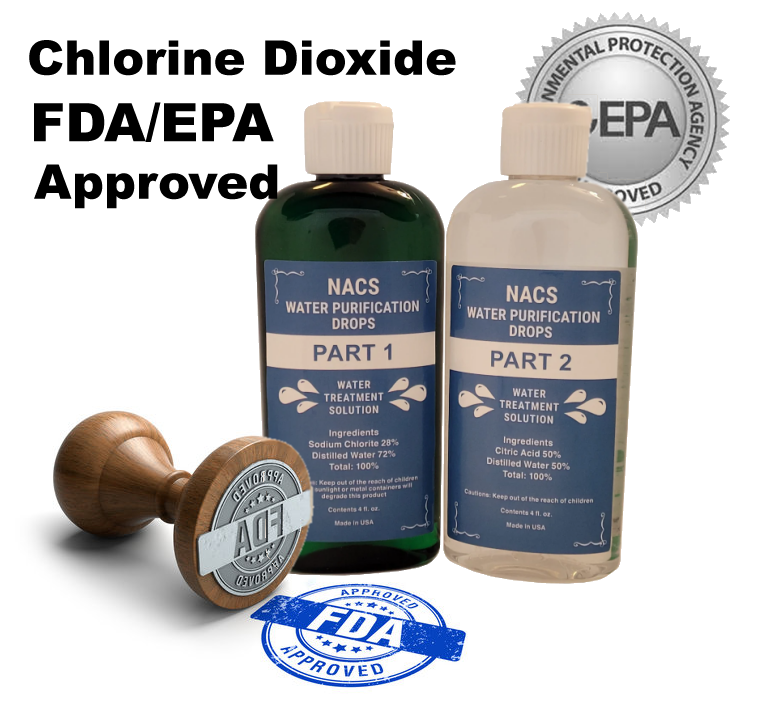You might wonder why NACS uses chlorine dioxide as the foundation of their Natural Antibacterial Cleaner Solution as featured in Water Purification Drops. The reason the U.S. Food and Drug Administration (FDA) and U.S. Environmental Protection Agency (EPA) approved chlorine dioxide is used as the NACS water treatment drops is due to being the undefeated champion of killing off all known pathogens including bad bacteria, fungus, parasites, and viruses, without being a threat to any other healthy cells or bacteria. No other chemical solution used in water treatment can achieve such sanitary status.
Chlorine Dioxide Makes Your Food Safe to Eat
Chlorine dioxide has emerged as a powerhouse sanitizer that is gaining increasing attention within the food processing industry. As food processors seek more effective sanitation solutions, nothing safe to use is more powerful than chlorine dioxide. It boasts approval from both the FDA and the EPA, positioning itself as the safest potent dominator. Remarkably, it matches the efficacy of peracetic acid while surpassing traditional options like quaternary ammonium salts, chlorine, or bromine. What sets it apart is its minimal environmental impact, making it the best choice for food processing facilities.
In terms of cost, chlorine dioxide aligns with other sanitizers, but its versatility and environmental friendliness make it an attractive alternative. Additionally, it has demonstrated the ability to combat biofilms effectively, a substantial challenge for food processors battling harmful bacteria. Dissimilar to and unlike chlorine, it doesn’t carry the burden of a strong odor or corrosive properties.
Chlorine dioxide’s versatility extends across various sanitation applications, including pasteurization equipment, heat exchangers, cooling towers, hard surface disinfection, potable water treatment, and deodorizing stacks in rendering plants. It has gained traction in the dairy industry, beverage production, fruit and vegetable processing, canning facilities, and poultry and beef processing plants. This multifaceted utility has made it the favored choice for those in the food processing sector.
The oft attacked meat, poultry, microbrewery, and food industries are dependent on the utilization of the most powerful and safe most advanced cleaning and sanitation methods to continue to grow and remain profitable throughout providing their services to the end user. This one chemical, chlorine dioxide can be depended on to eliminate pathogen sources, while combatting their transmission within and throughout food plants, and defeating biofilm formation.
Chlorine dioxide boasts several key advantages:
-
- Exceptional Oxidizing Power: With 2.6 times the oxidizing strength of waterborne chlorine, chlorine dioxide effectively addresses a broad spectrum of microorganisms, with studies indicating up to a 6-log reduction.
- Wide pH Tolerance: Unlike chlorine, chlorine dioxide accommodates a broader pH range, enhancing its adaptability in diverse applications. It remains a true gas in solution and reacts minimally with water or organics.
- EPA and FDA Approval: Chlorine dioxide is registered with the EPA and approved by the FDA and USDA for use in food processing facilities, both as a disinfectant and food-contact surface sanitizer.
- Biofilm Disruption: It excels at dispersing biofilms, making it particularly valuable in facilities with cooling towers, where biofilm buildup poses challenges.
- Low Concentration Requirements: Diluted concentrations as low as 5 parts per million (ppm) on food-contact surfaces demonstrate its efficiency, resulting in cost-effectiveness.
- Resistance Prevention: Unlike some sanitizers, chlorine dioxide exhibits a lower likelihood of resistance development among problem cells.
- Versatile Applications: Chlorine dioxide generators can serve purposes ranging from odor control to sanitation and water purification, offering consistency and practical yield.
- Environmental Responsibility: Chlorine dioxide’s breakdown into water, oxygen, and table salt minimizes its corrosiveness and environmental impact. It doesn’t contribute to the formation of harmful trihalomethanes like chlorine bleach and bromide.
Chlorine dioxide’s impressive range of attributes, encompassing potency, versatility, and environmental responsibility, positions it as the standout choice for sanitation in the food processing industry. Its multifaceted utility, safety, and efficacy make it an invaluable asset, driving its adoption among food processors striving to raise the bar for cleanliness and safety.
Using NACS water treatment drops in the kitchen at home
Vegetable Rinse
When it comes to washing your vegetables to remove pathogens, pesticides, and chemicals used in processing, you can create a very mild rinse solution.
How to use NACS drops as a vegetable rinse:
Ingredients:
-
- 9 drops of Part 1
- 9 drops of Part 2
- One gallon of water
Instructions:
-
- Activate Part 1 and Part 2 by combining 9 drops of each.
- Allow the mixture to activate for 3 minutes.
- Add the activated solution to one gallon of water.
Use this solution to rinse or dip your vegetables.
Let your veggies soak for 1 minute. Rinse them thoroughly, cook as desired, and enjoy!
Food Prep Equipment
(Including kitchen utensils and cutting board)
For keeping your food prep equipment, kitchen utensils, and cutting boards, countertops, etc., clean, and environmentally friendly, you can use a mild solution.
How to use NACS drops to sanitize food prep equipment:
Ingredients:
-
- 8 drops of Part 1
- 8 drops of Part 2
- 8 oz of distilled water
Instructions:
-
- Activate Part 1 and Part 2 by combining 8 drops of each.
- Allow the mixture to activate for 3 minutes.
- Mix the activated solution with 8 oz of distilled water.
Simply spray or wipe this solution onto your surfaces. No rinsing is required, and it leaves no toxic byproducts behind.
Other Kitchen Gear
Such as ice makers, coffee pots, home breweries, etc.
You can also use the same mild solution for cleaning coffee pots, home breweries, iced tea makers, and ice machine lines.
How to use NACS drops to sanitize coffee pots and iced tea makers:
- Fill the water tank with the mild solution.
- Turn on the appliance.
- Rinse by adding fresh distilled water and running the cycle a couple of times.
This will clean the system and help remove any biofilm.
How to use NACS drops for ice machine lines:
- Turn off the water supply first.
- Run the mild solution through the lines.
- Allow it to sit for a few minutes before rinsing.
Tableware
Including stainless silverware, glassware, dishes, etc.
Soaking your dishes, glasses, and stainless-steel silverware can effectively remove biofilm, grease, and leave everything clean and sparkling.
How to use NACS drops to sanitize your tableware:
Instructions:
- Fill your sink with dishes, glasses, and silverware.
- Activate 30 drops of Part 1 & Part 2 and let them sit for 30 seconds.
- Add the activated solution to the sink.
- Allow your items to soak for 10 minutes or more.
This method is particularly effective for cleaning the area between fork tines, where regular washing may struggle.
With these solutions, you can maintain a clean and safe food preparation environment at home and ensure your produce is free from unwanted chemicals and contaminants using the power of chlorine dioxide.






